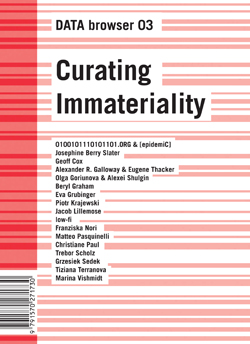Hans-Ulrich Obrist: A Brief History of Curating (2008)
Filed under book | Tags: · art, conceptual art, contemporary art, curating, exhibition

11 interviews with curatorial pioneers.
This publication is dedicated to pioneering curators and presents a unique collection of interviews by Hans Ulrich Obrist: Anne d’Harnoncourt, Werner Hofman, Jean Leering, Franz Meyer, Seth Siegelaub, Walter Zanini, Johannes Cladders, Lucy Lippard, Walter Hopps, Pontus Hultén, and Harald Szeemann are gathered together in this volume.
The contributions map the development of the curatorial field, from early independent curating in the 1960s and 1970s and the experimental institutional programs developed in Europe and in the USA at this time, through Documenta and the development of biennales.
The book is part of the Documents series, co-published with Les presses du réel and dedicated to critical writings.
Colaboradores Hans-Ulrich Obrist, Lionel Bovier
Publisher JRP / Ringier, 2008
Volume 3 of Documents Series
ISBN 390582955X, 9783905829556
302 pages
Download (removed on 2014-1-7 upon request of the distributor)
Comment (0)Journal of Neuro-Aesthetic Theory, No 1-5 (1997-2011)
Filed under e-zine | Tags: · aesthetics, architecture, art, biopolitics, brain, cinema, cognition, cognitive capitalism, curating, film, mind, neuroaesthetics, neurobiopolitics, philosophy, science, theory
Journal of Neuro-Aesthetic Theory #5 (2007-11)
Neurobiopolitics, Pluripotentiality and Cognitive Capitalism, a work in progress…
View online (HTML articles)
Journal of Neuro-Aesthetic Theory #4 (2005-07)
Conference of Neuroaesthetics
View online (HTML articles)
Journal of Neuro-Aesthetic Theory #3 (2003-04)
Buildings, Movies and Brains.
View online (HTML articles)
Journal of Neuro-Aesthetic Theory #2 (2000-02)
Cinema and the Brain
View online (HTML articles)
Journal of Neuro-Aesthetic Theory #1 (1997-99)
Introduction to Neuro-Aesthetic Theory
View online (HTML articles)
Contributors: Warren Neidich, Charles T. Wolfe, Andrew Patrizio, Philippe Rahm, Meena Alexander, Michael Madore, Martina Wicklein, Martina Siebert, Norman M. Klein, Michael Salcman, Nicholas Wade, Nicholas Chase, Nathalie Angles, Martha Trivizas, Nicola Diamond, Mark Cohen, Lev Manovich, Laura U. Marks, Lucy Steeds, Mark Bishop, Olafur Eliasson, Margarita Gluzberg, Marcos Novak, M. A. Greenstein, Marquard Smith, Paul D. Miller -DJ Spooky, Vivian Sobchack, W. H. Zangemeister, Thyrza Goodeve, Warren Sack, Zoe Beloff, Yann Beauvais, William Hirstein, Stuart Brisley, Peter Brugger, Ralph Greenspan, Penny Starfield, Kodwo Eshun, Sarat Maharaj, Scott Lash, Steven Holl, Karen Beckman, Colin Gardner, Conerly Casey, Christiane Paul, Chloe Vaitsou, Daniel Blaufuks, Diana Thater, Ken Jacobs, Dennis Balk, David J. McGonigle, Charlie Gere, Armen Avanessian, Arnold H. Modell, Anjan Chatterjee, Andreas Roepstorff, Barbara Marie Stafford, Brian Massumi, Bernard Andrieu, Beau Lotto, Elizabeth Cohen and Michael Talley, John Welchman, Janet Sternburg, Elizabeth S. CohenJonathan Green, Joseph Kosuth, Andrea Grunert, Juli Carson and Lindi Emoungu, Jules Davidoff, Isabelle Moffat, Israel Rosenfeld, Francois Bucher, Eric Duyckaerts, Ellen K. Levy and David E. Levy, gruppo A12 and Francisca Insulza, Gregg Lambert and Gregory Flaxman
Initiated by Warren Neidich
Comment (0)Joasia Krysa (ed.): Curating Immateriality: The Work of the Curator in the Age of Network Systems (2006)
Filed under book | Tags: · aesthetics, art, collaboration, curating, database, exhibition, internet, internet art, labour, media art, museum, net art, open source, relational aesthetics, software art, technology

“The site of curatorial production has been expanded to include the space of the Internet and the focus of curatorial attention has been extended from the object to processes to dynamic network systems. As a result, curatorial work has become more widely distributed between multiple agents, including technological networks and software. This upgraded ‘operating system’ of art presents new possibilities of online curating that is collective and distributed — even to the extreme of a self-organising system that curates itself. The curator is part of this entire system but not central to it.
The subtitle of the book makes reference to the essay ‘The Work of Culture in the Age of Cybernetic Systems’ (1988), in which Bill Nichols considered how cybernetics transformed cultural production. He emphasised the shift from mechanical reproduction (symbolised by the camera) to that of cybernetic systems (symbolised by the computer) in relation to the political economy, and pointed to contradictory tendencies inherent in these systems: ‘the negative, currently dominant, tendency toward control, and the positive, more latent potential toward collectivity’. The book continues this general line of inquiry in relation to curating, and extends it by considering how power relations and control are expressed in the context of network systems and immateriality.
In relation to network systems, the emphasis remains on the democratic potential of technological change but also the emergence of what appears as more intensive forms of control. Can the same be said of curating in the context of distributed forms? If so, what does this imply for software curating beyond the rhetoric of free software and open systems?”
Contributors: 0100101110101101.ORG & [epidemiC] | Josephine Berry Slater | Geoff Cox | Alexander R. Galloway & Eugene Thacker | Olga Goriunova & Alexei Shulgin | Beryl Graham | Eva Grubinger | Piotr Krajewski | Jacob Lillemose | low-fi | Franziska Nori | Matteo Pasquinelli | Christiane Paul | Trebor Scholz | Grzesiek Sedek | Tiziana Terranova | Marina Vishmidt
Publisher Autonomedia/I-DAT, 2006
Creative Commons License
DATA browser series, 3
ISBN 1570271739
288 pages
PDF (14 MB, added on 2018-3-29)
PDFs (updated on 2016-12-12)

